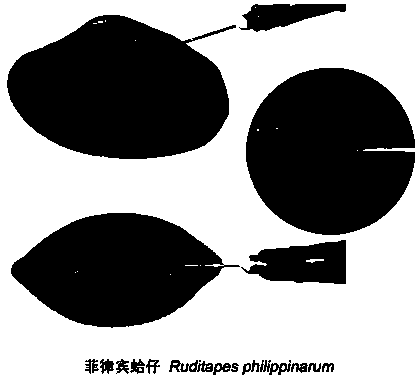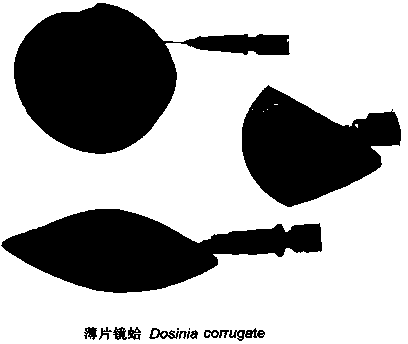Zero-damage injection method of immune reaction allogenes of veneridae shellfish
A technology of immune response and clams, applied in the field of marine organisms, can solve the problems of test error, shellfish stress response, large labor load, etc., and achieve the effects of simple and easy operation, simple and easy-to-obtain utensils, and small errors.
- Summary
- Abstract
- Description
- Claims
- Application Information
AI Technical Summary
Problems solved by technology
Method used
Image
Examples
Embodiment 1
[0017] In January 2014, in the Liaoning Provincial Shellfish Breeding Engineering Technology Research Center, the method disclosed in the present invention was used to carry out infection and immunity tests on Philippine clams. Such as figure 1 shown.
[0018] Pathogens are: peptidoglycan (PGN), β-whole glucan particles (WGP), outer membrane proteopolysaccharide (LPS) or viral double-stranded RNA complex (PIC), all at a concentration of 100 μg / mL; first prepare once Use a sterile sterile syringe to absorb the pathogen solution, and determine the intersection point between the end of the outer ligament of the Philippine clam and the edge of the shell. Adjust the tangent angle between the needle point and the edge of the shell to be 35 degrees, send the needle point into the soft body of the Philippine clam, and input the pathogen (one of PGN, WGP, LPS, PIC) into the Philippine clam, after the operation, the Philippine clam Aberdeen can survive normally, and 100% immune respon...
Embodiment 2
[0021] In February 2014, in the Liaoning Provincial Shellfish Breeding Engineering Technology Research Center, the infection and immunity test of clam lamina was carried out with the method disclosed in the present invention. Such as figure 2 shown.
[0022] Pathogens are: peptidoglycan (PGN), β-whole glucan particles (WGP), outer membrane proteopolysaccharide (LPS) or viral double-stranded RNA complex (PIC), all at a concentration of 100 μg / mL; first prepare once Use a sterile sterile syringe to absorb the pathogen solution, and determine the intersection point between the end of the outer ligament of the clam and the edge of the shell. Adjust the tangent angle between the needle point and the edge of the shell to be 55 degrees, send the needle point into the soft body of the clam lamina, and input the pathogen (one of PGN, WGP, LPS, PIC) into the clam lamina. Aberdeen can survive normally, and 100% immune response occurs.
[0023] Among them, the input experiment was car...
PUM
 Login to View More
Login to View More Abstract
Description
Claims
Application Information
 Login to View More
Login to View More - R&D
- Intellectual Property
- Life Sciences
- Materials
- Tech Scout
- Unparalleled Data Quality
- Higher Quality Content
- 60% Fewer Hallucinations
Browse by: Latest US Patents, China's latest patents, Technical Efficacy Thesaurus, Application Domain, Technology Topic, Popular Technical Reports.
© 2025 PatSnap. All rights reserved.Legal|Privacy policy|Modern Slavery Act Transparency Statement|Sitemap|About US| Contact US: help@patsnap.com


